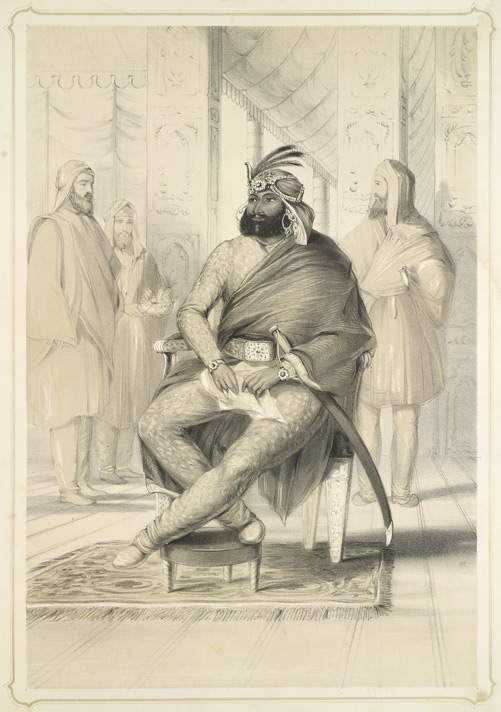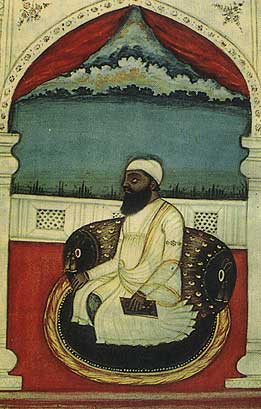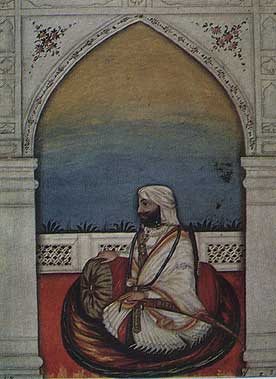If one picks up any college history or even school book in the state of Jammu & Kashmir, the Sikh or Sarkar Khalsa (as Maharaja Ranjit Singh referred his state) rule from 1819 to 1846 is termed as 'exploitive' and 'oppressive'.
In 1819, Maharaja Ranjit Singh annexed Kashmir which ended the Afghan rule. This was first time in 500 years that a non-Islamic government was ruling Kashmir. Maharaja Ranjit Singh's government was a mixture of Hindus, Sikhs and Muslims. As I discuss the Sarkar Khalsa's rule, I will try to evaluate the allegations of 'exploitive' and 'oppressive'. During the 27 years of rule, a number of governors were appointed. We will examine each of them.
Diwan Moti Ram (1819-20)
He was the son of famous Diwan Mohkam Chand, a Hindu Khatri who was at the service of both Maha Singh and his son Ranjit Singh. Lepen Griffin calls him "the best governor", who was "kind-hearted and liked by the people". He introduced number of measures
- Cow slaughter was banned, as it was in all territories under Sarkar Khalsa,
- Call for public Azan was stopped,
- Congregational prayers on Fridays in the Jama Masjid of Srinagar were stopped
- The Afghan soldiers used to kidnap the pretty girls for their ever expanding harems. This practice came to an end,
- The terror of Sikh name brought an end to thefts and robbery.
Cholera
Dr Hari Ram Gupta writes that the Sikh rule was welcomed both by Hindus and Muslims but Moti Ram had to contend with a natural calamity. Cholera took a heavy toll of the population, shortly after the occupation of Kashmir. Diwan Devi Das from Lahore was deputed to report on the condition of the country. He presented a painful picture of the people. The grain was scarce and due to difficult terrain it was difficult and time consuming to send them to the rural areas. In desperation people were willing to sell their children for food and it had an impact on law and order. It was reported that Moti Ram was doing his best, but his officers lacked sympathy.
In 1820 his eldest son, Ram Dayal, a fine soldier, was killed in Hazara at the age of about 20. Moti Ram was so heartbroken that he resigned his governorship in June, 1820, and retired to Banaras.
Hari Singh Nalwa was perhaps the greatest military general under Maharaja Ranjit Singh. He introduced various measures
- Removed all the restrictions imposed on Kashmiri Pandits under the Afghan rule regarding worship, dress, and some customs.
- The Hindus forcibly converted to Islam were allowed to return to their original religion.
- Abolished 'Begar' meaning forcible unpaid service by villagers to government officials.
- Reduced the government share in the produce of saffron, and thus encouraged its cultivation.
- Insisted on right type of weight and measures.
- Constructed Gurdwara at Kathi Darwaza, Srinagar, Matan and Baramula, which were associated with the visit of first and sixth Guru of the Sikhs namely Guru Nanak and Guru Hargobind.
Moti Ram persuaded the Maharaja to reduce the Kashmir tribute from 52 lakhs to 26 lakhs. He checked corruption in the administration, developed agriculture, industry and trade (both internal and external).
Law and order under the Sarkar Khalsa in Kashmir was very good. The Sikh army only had 3,000 infantry and 1,000 cavalry. During the previous rule, the Afghan governors maintained a force between 16,000 and 20,000.
Chuni Lal (1826-27)
Chuni Lal, a protégé and a 'pliant tool' of the Dhian Singh Dogra was appointed Governor of Kashmir. His real objective was to bring Kashmir under the direction of Jammu (Gulab Singh had internal autonomy over Jammu). The Maharaja disliked hearing complaint about his Prime Minister and said many times that the complaint against Dhian Singh should only be made to the immortal God!
Chuni Lal had little skill at administration. Over a case of cow slaughter, the guilty persons were hanged and their bodies were dragged through the main bazars of Srinagar. This created great commotion, and he was recalled in November, 1827.
Diwan Kirpa Ram (1827-31)
In December, 1827, Maharaja appointed Diwan Moti Ram's second son, Diwan Kirpa Ram, governor of Kashmir. Earlier he had held charge of Hazara and the Jalandhar Doab. According to Lepen Griffin both father and son were the best governors of Kashmir. HR Gupta writes that Kirpa Ram like his father and grandfather was very honest and incorruptible. He constructed many fine buildings and lovely gardens at Srinagar.Earthquake, Cholera & Jihad
During his governorship, the great earthquake of 1828 took place and a large number of buildings and houses collapsed. It was followed by the cholera epidemic. To make matters worse, the Bambas and Kakkas community rose in rebellion at the instigation of Syed Ahmad Barelvi. Interestingly the Syed who was a Wahabi from Uttar Pradesh and had declared Jihad against Ranjit Singh found no support among Punjabi Muslims. The Maharaja was able to integrate Punjabis but in Kashmir the majority community saw his rule as alien.
On flimsy grounds, Dhian Singh Dogra persuaded the Maharaja to dismiss Kirpa Ram and he was removed in February 1831. Later the Maharaja granted him the jagir of Kunjah worth 3 lakhs annually in December, 1831 but the Diwan felt humiliated and later crossed into British territory and never returned to the Punjab. HR Gupta writes that Dhian Singh "admirably succeeded in eliminating one great and influential family at the Court."
Bhama Singh Ardali (1831)
The Maharaja was very busy with the final battle with Syed Ahmed Barelvi and no one was sent to Kashmir. Bhama Singh Ardali who was already in Kashmir, took charge in January, 1831. He was poor administrator. During his tenure Sunni-Shia riots broke out. Ardali failed to control them. There was an enormous loss of life and property. It is mentioned that about 300 Irani Shia merchants who had permanently settled in the valley went back to Iran. Ardali was recalled in November, 1831.
 Prince Sher Singh (1832-34)
Prince Sher Singh (1832-34)Kunwar Sher Singh, son of Maharaja Ranjit Singh who had crushed Barelvi's Jihad (he was killed as well) was given the governorship of Kashmir. He was also very close to the Dogras. Sher Singh was a very good military commander but had little interest in civil duties. Realising this, Maharaja had send Wasakha Singh to look after the revenue but he forcibly collected from the traders over 7 lakhs (for himself) and remitted another 2 lakhs to the Lahore treasury. The Maharaja's intelligence informed him and Wasakha Singh was brought to Lahore in chains and a hefty fine was realised from him.
The Maharaja tried a balancing act, a trio - two Sikhs and one Muslim, were appointed to look after the revenue. They were Jamadar Khushhal Singh (Brahmin from Meerut who became Sikh), Gurmukh Singh and Sheikh Ghulam Mohiuddin. Regrettably, they came to an understanding to share the loot in common. Jamadar was later on censured, while Ghulam Mohiuddin's property was confiscated.
Famine
In 1833 a serious famine broke out in Kashmir. A large number of people died of starvation. Many migrated to Punjab and British India.
The Maharaja sent large quantities of grain laden on thousands of donkeys. In villages grain was distributed through mosques and temples. In big towns and cities of Kashmir, the troops collected people in open spaces in rows and each was given two kg of grain daily for their families.
Mihan Singh (1834-41)
On 14th February, 1832, Mohan Lal Kashmiri recorded in his diary "Mihan Singh is the bravest commander in Ranjit Singh's army, and has fought a great many battles, in which he has received many wounds."
Colonel Mihan Singh took charge of his new post in October, 1834 and appointed Pandit Ganesh Dar as his Chief Minister. They took the following measures
- Abolished duties on grain and other necessary articles of daily consumption.
- Imported large quantities of grain and poultry from the Punjab.
- Black marketers were severely punished.
- To encourage cultivation, he gave relief in land revenue, and granted 'taqavi' loans liberally to cultivators.
- He promoted trade by reducing tariff duties. Shawl factory owners were given loans to increase production. Imports and exports with Ladakh, Punjab, British India, Afghanistan and Central Asia were developed.
- Serais were built at convenient places for traders and travellers.
- Facilities of credit and correspondence through state postal service were provided.
- Suppressed an organized body of thugs called Galwans. They roamed about, committed dacoities, and carried off beautiful girls. Khaira Galwan was their leader. Mihan Singh rooted them out (Vigne).
- He laid out 'Basant Bagh' and planted fine chinar trees which still exist in that garden. The tribal revolts were crushed with a strong hand.
- Complied 'Tarikh i Kashmir', a document of much historical and economic importance
Jia Lal Kalam has given a good account of this dispute. The shawl weavers and shawl merchants were Shias, and as a result of Shia-Sunni riots, the Shias were leaving the valley for Amritsar, Ludhiana & Jammu. The natural calamities made the things worst. Meanwhile Raja Gulab Singh Dogra was encouraging weavers in Jammu. Following the occupation of Kishtwar, a shorter though a difficult route was opened to Ladakh where the wool for the shawls came. Gulab Singh managed to divert the wool direct to Jammu through his newly acquired district of Kishtwar. This resulted in considerable damage to shawl industry of Kashmir and consequently there was unemployment and poverty. Mihan Singh tried to apprise the Maharaja of this state of affairs, but due to the presence of Dhian Singh Dogra, who was the Prime Minister at Lahore, the information was kept back from the Maharaja. Finally a letter was sent through a trusted servant and with a direction that he should deliver the letter directly in the hand of the Maharaja. The Maharaja expressed his dissatisfaction and some raw wool started coming to Kashmir.
Mihan Singh & Dogras had a bit of history. According to Brigadier Gurbachan Singh Bal, earlier in 1834 when the situation in Ladakh became favourable, Mihan Singh had expressed a desire to lead a campaign to the province but Dhian Singh Dogra was able to convince the Maharaja to allow Gulab Singh Dogra to do it, who instructed Zorawar Singh to carry out the mission. Mihan Singh was asked to cooperate with Jammu. Later when Ladakhi revolted, Dogras accused Mihan Singh for instigating it.
Sadly, after the death of Maharaja, the state of intrigues in Lahore had an impact at Kashmir. Soon after Maharaja Sher Singh's accession, two battalions of the Sikh army in Kashmir revolted and in April 1841 assassinated Mihan Singh at his residence in Srinagar. Pandit Ganesh Dar who had been personally honoured by Maharaja at Lahore also died within a fortnight of Mihan Singh's death.
 Sheikh Ghulam Mohiuddin (1841-46)
Sheikh Ghulam Mohiuddin (1841-46)Ghulam Mohiuddin had previously been recalled from Kashmir for being harsh and corrupt but he was a changed man by now. He started as the Governor of Kashmir in 1841 and appointed Pandit Tilak Chand Munshi as his Chief Minister. They continued the good work by Mihan Singh & Pandit Ganesh Dar and took the following measures
- Jama Masjid which was kept closed for public prayers since 1819 was now left open for prayers.
- After winning goodwill, he supressed the frontier Muslim hill chieftains who having taken advantage of prevailing turmoil and had become semi-independent.
- Streamlined the administration
- Laid two gardens which to this day commemorate their names, Sheikh Bagh and Munshi Bagh.
 Sheikh Imamuddin (1845-46)
Sheikh Imamuddin (1845-46)The younger Sheikh kept Pandit Tilak Chand Munshi as his Chief Minister. He took various measures to promote shawl trade
- Paddy was supplied to the weavers from the state granaries at a price which was less by two annas in a rupee.
- The shawl manufacturers were directed to give the weavers a bonus of three percent from their profits.
- Ordered increments for the weavers.
The arrangement was resented by Raja Lal Singh (Brahmin from Jhelum who became Sikh), who had colluded with British during the war. In a private communication he instructed Shaikh Imamuddin to obstruct handing over to Gulab Singh. Ultimately Major Henry Lawrence had to intervene to whom he surrendered. Imamuddin was tried by the British at Lahore but was exonerated when he produced original letters written by Raja Lal Singh. His property in Lahore, which was earlier confiscated, was restored to him. He died in March 1859 at the early age of 40 and was buried in the vicinity of the tomb of the famous Sufi, Data Ganj Bakhsh, at Lahore.
Conclusion
There is no doubt that some of senior officials were greedy and corrupt but they were immediately recalled to Lahore and were punished. Unfortunately Nature played havoc during the Sikh rule in Kashmir. Some of the measures like ban on cow slaughter and Azan were seen as anti-Muslim. Hence in the eyes of most historians it was an oppressive regime. Syed Ahmed Barelvi's call for Jihad against Maharaja Ranjit Singh found support in Kashmir unlike Punjabi Muslims who were not interested in it. Sectarian historians totally ignore the good work done with the Governors (who were Sikh, Hindus and Muslims) and the role played by Mother Nature. The rule was neither anti-Muslim nor pro-Hindu.
Unfortunately, we are very good at dividing history. As Sikhs blame Dogras for loss of Empire, the latter are happy for state historians to describe Sikh rule as 'exploitive'. Mihan Singh, among Dogras is known as the Sikh Governor who was jealous of them. They have not bothered to look into the change of dynamics of shawl trade between Jammu & region of Kashmir. As Sikhs are few in Jammu & Kashmir and not part of any vote bank, the establishment is happy is classify them as outsiders and not bothered with the propaganda by the so called historians. Another example of divided history is Maharaja Gulab Singh Dogra. He is seen as an icon in Jammu who never did anything wrong but in Kashmir his rule is also deemed as 'oppressive'. The reality as most of the time is somewhere in the middle.








No comments:
Post a Comment